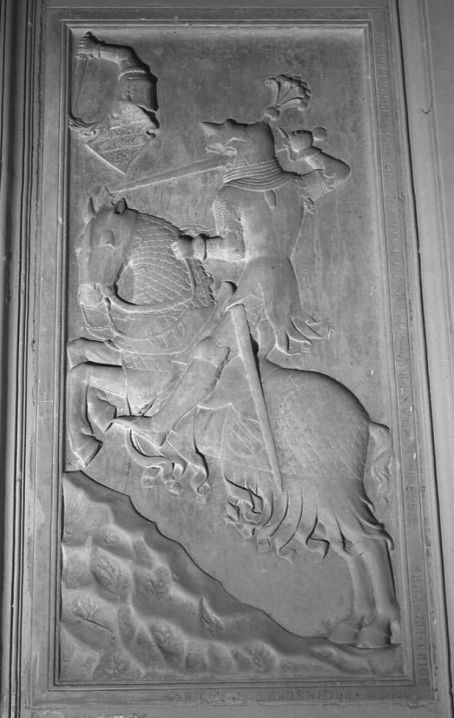
Shop Amazon - Create an Amazon Baby Registry
Tombstone of Tiberto IV Brandolini at Bagnacavallo, Italy, c.1397



La lastra rettangolare reca a bassorilievo sul fondo liscio l'immagine di Tiberto Brandolini (morto nel 1397). rappresentato a cavallo, serrato nella sua armatura, con la spada sguainata in pugno. Il cavallo, rivestito di un'armatura a scaglie e di una gualdrappa dai lembi svolazzanti, si impenna verso sinistra, sovrastando un monticello roccioso nelle cui anfrattuositą crescono delle piantine. Nell'angolo superiore sinistro compare lo stemma del defunto (tre sbarre con scorpioni) sovrastato dall'elmo che culmina in un braccio armato.
Datazione: sec. XIV ; 1397 - 1398
Materia tecnica: pietra d'Istria/ scultura
Misure: alt. 235, largh. 115,
Source: Beni-Culturali codice 08 00025523
The rectangular slab has in bas-relief on the smooth background the image of Tiberto Brandolini (died in 1397). Depicted on horseback, enclosed in his armour, with his drawn sword in his hand. The horse, covered with a scaled armour and with a fluttering saddle cloth, rears up to the left, overhanging a rocky mound in which the seedlings grow in anfractuosity. In the upper left corner appears the emblem of the deceased (three bars with scorpions) surmounted by a helmet that culminates in an armoured arm.
Dating: 14th century; 1397 - 1398
Technical material Istria stone / sculpture
Dimensions: 235cm high, 115cm wide.
An extract from Armies of the Middle Ages, volume 1 by Ian Heath:
There are only two 14th century Italian tombstones depicting mounted men-at-arms, figure 75 being one and this figure, Tiberto IV Brandolini, being the other. There is nothing remarkable about his harness except for the strap attaching his helmet to the backplate worn beneath his jupon, such straps occurring in a considerable number of late-14th and early-15th century pictures. What is remarkable, however, is the horse-armour, probably comprising a mixture of leather and metal. The chanfron, crinet and bossoirs (or glancing-knobs) are all undoubtedly metal, while the scales might be either metal or leather, mounted on a leather or thick fabric foundation.